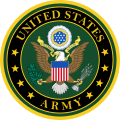This article needs additional citations for verification .(March 2012) |
Many Army divisions have over the years earned nicknames. Sometimes, the nicknames themselves have overshadowed the actual name of the division, such as the "Screaming Eagles" for the 101st Airborne Division.

